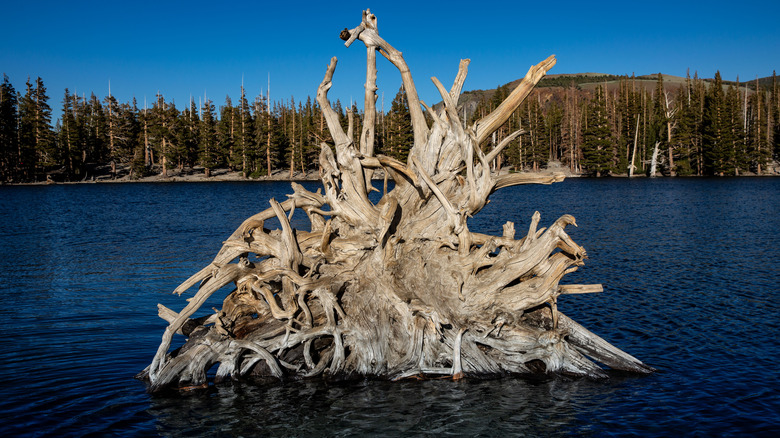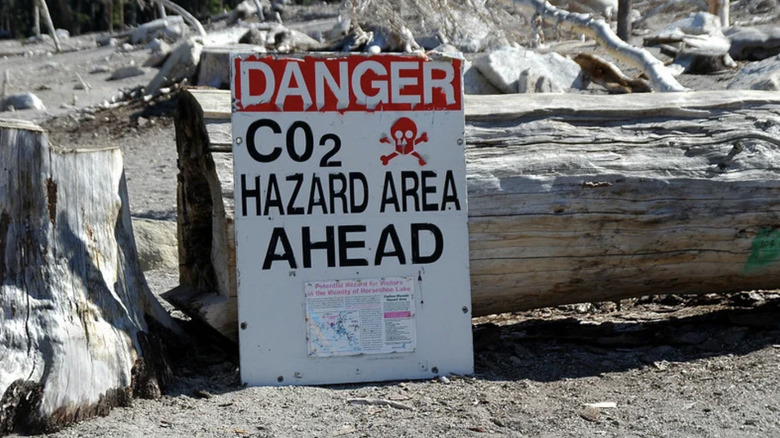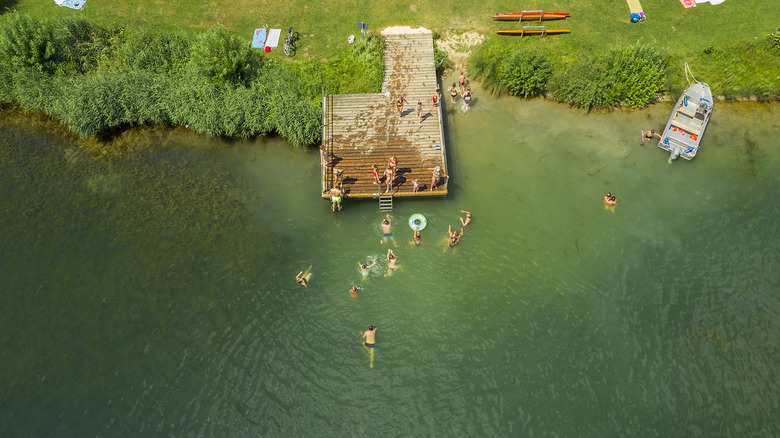The Seemingly Serene California Lake With A Dangerous Secret
Nestled beneath California's towering Mammoth Mountain volcano, at about an hour's drive from Yosemite National Park, is a beautifully haunting scene. Horseshoe Lake sits atop one of the largest active volcanic systems in the U.S. While its serene waters make it seem like one of the best lakes on the west coast for swimming, Horseshoe Lake houses a deadly secret. It's not mysterious wildlife, unpredictable currents, or extreme temperatures that make this lake one of the most dangerous in the country. The lake's secret is actually something that is invisible to the human eye: carbon dioxide. Travelers who come across this lake notice an eerie circle of dead trees stretching out before them. The cause of this decay is a gas reservoir that has long since been disturbed.
From May to November 1989, a series of small earthquakes struck the region and helped push carbon dioxide from these magma channels onto the surface where it dispersed throughout the surrounding soil and took out around 120 acres of trees. Author and content creator Geo Rutherford (@geodesaurus) published a TikTok series about "spooky" lakes around the world and featured Horseshoe Lake in a video.
@geodesaurus Reply to @amber.riehlrsw ⬅️follow for more spooky lakes!! 🐴👠 Lake in California #spookylake #greenscreen #laketok
To this day, the lake and its surrounding area remains toxic to humans and animals alike. This dangerous secret, however, does not stop visitors from flocking to this iconic destination, where you can swim and enjoy nature. Just make sure to avoid the areas with high carbon dioxide.
The toxic gas of Horseshoe Lake
Upon arriving at Horseshoe Lake, perhaps at the end of a long hike or a road trip, travelers may be tempted to jump into the water to cool off. And though the official Mammoth website states that this dangerous California lake is safe to swim in, visitors should take extensive precautions, because this is a site that has the potential for tragedy.
According to the Los Angeles Times, the toxic gas that fumes from the volcanic vents around the lake can be made up of 98% carbon dioxide and 0.005% hydrogen sulfide. Humans usually take in about 0.03% of carbon dioxide with each inhale. If those levels reach 10% to 20%, the results can be deadly. And hydrogen sulfide can cause damage even in small doses.
These gases are denser than air, so they often sink and pool beneath the snow. The snow can hide these volcanic vents, making the nearby area unknowingly toxic. In 2006, three ski patrol members came across one of these pools when they fell into a cave and died from carbon dioxide poisoning. They were moving a fence that discouraged skiers from coming too close to the toxic gas (don't do this!) when they fell through the snow. Eight years later, another traveler met a similar fate.
Proceed with caution at Horseshoe Lake
Despite the grim reality of Horseshoe Lake, many people travel here for a good swim. In fact, Horseshoe Lake is the only lake in the Mammoth basin where swimming is permissible. It has a wide beach to lounge on or launch kayaks and paddleboards from. There is a 7-mile loop trail perfect for mountain biking, and there are plenty of additional hiking trails to explore.
Potential visitors can find solace in the fact that the carbon dioxide levels in this region change with the seasons. The U.S. Geology Survey (USGS) says that the area is safer in the summer months when the craving for a good swim is greater. In the winter, however, carbon dioxide levels are much more severe. Regardless of when you go, always pay attention to the signs that block off the toxic volcanic vents.
If you are planning on taking a dip in Horseshoe Lake, there are some safety precautions you can take. Along with basic water safety practices, like never swimming alone, keeping children at arm's length from an adult, and wearing a life vest, visitors can protect themselves is by being hyperaware of their sense of smell. Hydrogen sulfide gives off a smell similar to rotten eggs. Horseshoe Lake is a beautiful force of nature and, despite the toxic gas, is not as spooky as it seems — as long as visitors are aware of the risks and take proper precautions while visiting.


